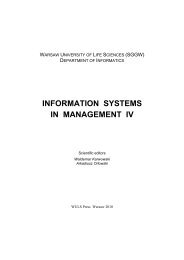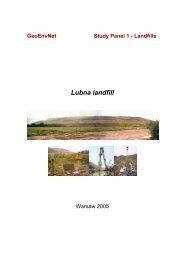ACTA SCIENTIARUM POLONORUM - SGGW
ACTA SCIENTIARUM POLONORUM - SGGW
ACTA SCIENTIARUM POLONORUM - SGGW
You also want an ePaper? Increase the reach of your titles
YUMPU automatically turns print PDFs into web optimized ePapers that Google loves.
88 M. Renigier-Biłozor, R. WiśniewskiANALYSIS OF THE EFFICIENCY OF SELECTED RE MARKETS IN POLANDData from various real estate markets in Poland for 2008–2010 are presented in Table1 with reference to population statistics. The analyzed data constitute a benchmarkfor measuring the size and efficiency of real estate markets in selected Polish cities, andit accounts for: population, unemployment rate, average gross monthly wages, area insquare kilometers, number of real estate transactions separately for land plots and apartments,and the average price per sq. m. of apartment area. The data have been used toanalyze real estate market efficiency. At this stage of the analysis, the choice of data wasdictated by the ease of acquisition and the availability of the relevant information. Thereal number of transactions on a given local market (city) proved to be most problematic.It could be postulated that the level of difficulty with acquiring the relevant data wasreversely proportional to city size (population and area). According to the authors, theabove theory is supported by the following arguments:––––lack of data gathering systems in the public domain,lack of data sorting algorithms in units and departments responsible for data accumulation,lack of advanced systems for updating, processing and releasing data,the units and departments responsible for gathering public information are reluctantto create access to the data.If the efficiency of Polish real estate markets were to be evaluated based on the criterionof data availability, the majority of Polish cities would receive low or very lowmarks. Access to information is an important, yet not the only factor determining marketefficiency. Two indicators were computed based on the assumption that the acquired dataare credible:1. PO/RET – population per 1 real estate transaction,2. HA/GW – housing area in square meters that can be purchased with an average grossmonthly wage.The two indicators can be used to perform a simplified classification of the efficiencyof selected real estate markets in Poland. The first indicator, PO/RET, indicates the size ofthe local population per 1 real estate transaction, and the higher its value the lower the efficiencyof the local market. The second indicator, HA/GW, is a price to income ratio thatmeasures the affordability of real estate, and the higher its value, the higher the efficiencyof the real estate market. The value of the second indicator illustrates the correlation betweenreal estate prices and incomes on the local market.Real estate markets are ranked according to the adopted indicators in Tables 2 and3. An analysis of Table 2 data indicates that a given market’s place in the ranking is notdetermined by the size of the city, its population or the unemployment rate. The rankingis topped by medium-sized cities with a population nearing 100,000 – Zielona Góra,Koszalin and Słupsk. Table 3 suggests a certain trend, namely that real estate prices aremore affordable in smaller cities, in this case – Ciechanów, Działdowo and Kętrzyn. Ananalysis of both tables shows a certain analogy as regards similar positions occupied byBydgoszcz, Łódź, Suwałki and Ełk.Acta Sci. Pol.
















